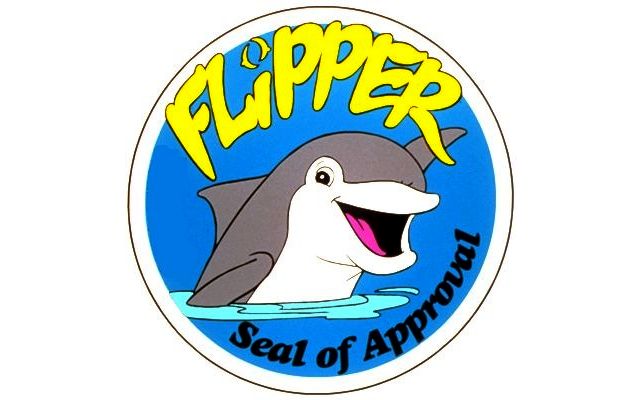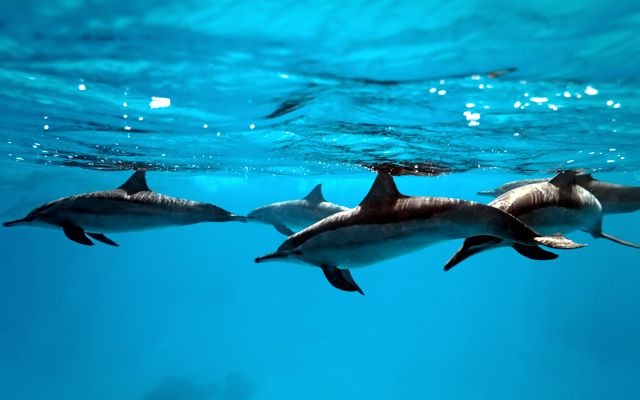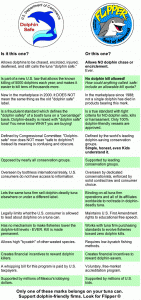Meet Flipper. His face helped invent dolphin-friendly tuna. And he keeps it real.
What about “Sustainable Seafood”?
There are a number of organizations which recently have pushed the concept of “sustainable seafood”, and good for them.
The whole concept of catching large tuna has always been a pretty inefficient way of getting protein from the seas. It makes about as much sense as raising tigers for burgers. Tuna are high on the food chain, meaning it takes a lot of primary ecosystem productivity to make an ounce of tuna muscle. This position as a top carnivore is also what concentrates heavy metals and other bioaccumulants in tuna. It really makes sense to eat a lot farther down on the food chain.
That said, the global tuna industry is out there, and dolphins die. The FSA deals with the real world as it exists, and provides a stepwise mechanism to improve the situation of fisheries.
The “Flipper Seal of Approval”
was the first internationally-established labeling standard for tuna which avoids killing dolphins. It has been continuously in world markets since 1988. The Flipper standard was instrumental in the breakthrough to convince tuna firms to stop killing dolphins in 1990 (with the world’s largest tuna firm adopting the Flipper standard), and in spinning off the global “dolphin safe” tuna campaign.
As a voluntary program which is unconnected to legislation, it is immune to intervention by the WTO, NAFTA and other “free trade” treaties which have challenged and perverted some national “dolphin safe” standards.
The FSA program is a sophisticated strategy which rewards firms to continually evolve toward zero kill, while minimizing other bycatch as well.
There are currently a number of “dolphin safe” standards around the world, with different meanings, definitions and rules. Many of these continue to change, and many allow large numbers of dolphin kills associated with supposedly “safe” products! The term “dolphin safe” means many different things depending on whose “dolphin safe” standard you’re using.
The FSA, during its history, has been the both leading international program and a niche player, as legislation, treaty, and conservation group attention span ebb and flow. As “dolphin safe” standards fall under increasingly more pressure from mass-dolphin-killers and their allies, the FSA remains the program designed to fill the gap as “free trade” treaties make national dolphin-safety laws essentially illegal, or if legislation waters down national protections to the point of irrelevance. It exists, it’s legal, it has survived many challenges, and it means the same thing it always did: dolphin saving by responsible firms, with zero dolphin kills.
Is it dolphins versus other bycatch?
Many groups which really ought to know better have opposed dolphin safety as a goal, stating that it’s more important to save other species. This creates a destructive and misleading artificial choice.
Dolphins are not only a huge part of the bycatch in many sorts of tuna fishing, but they are the portion of the bycatch which has the lowest reproductive rate.
For instance, claims that large numbers of sea turtles are inherently killed in tuna purse seining are untrue. As critters who hold their breath well and have a shell, sea turtles nearly always survive the process of pursing and release unharmed. There have been leading scientists working at ET who are expert on tuna fisheries, and that’s what they’ve seen over their careers.
Former ET driftnet campaigner Sam Lubudde, who went undercover for other organizations on a tuna purse seining vessel, noted only one mechanism that harmed sea turtles… the cook on the vessel killing unharmed turtles to treat the crew. At ET, we’ve led the world fight for lower fisheries bycatch for decades – we were doing it successfully when the “other guys” were just saving cute fuzzy megafauna.
By all means, let’s work to end fisheries bycatch of all species, and let’s realize that dolphins are in many ways the most vulnerable part of tuna industry bycatch.
Clearing the Confusion over Dolphin-Friendly Tuna
The U.S. Definition of “Dolphin Safe”
In 1991, Clear and logical definitions of “dolphin safe” were established by the Dolphin Safe Consumer Information Act. However, in 1997, all such laws were re-defined by the IDCPA.
The new definition of “dolphin safe” is quite complex, includes an allowable ‘kill quota’ for “dolphin safe” products, and has been challenged in court by a number of conservation organizations which contend that it obscures a huge number of cryptic dolphin deaths.
In fact, under the U.S. laws implementing the IDCPA ‘dolphin safe’ definition, we apparently are not legally allowed to say bad things about the IDCPA program which could “mislead” consumers about its effectiveness. So do a little study and come to your own conclusions. Clearly, though, this revised definition of ‘dolphin safe’ does not even CLAIM to mean ‘zero dolphins killed’.
U.S. tuna firms complain that they have been locked out of the Eastern Tropical Pacific by the new federal definitions, since the “dolphin safe” policies of the tuna firms do not allow them to purchase tuna caught under the IDCPA’s ETP guidelines.
A problem with any ‘national legislative’ standard, is that a tuna company could be catching both “dolphin safe” and “dolphin unsafe” tuna, and selling the dolphin-unsafe tuna through other outlets (like to restaurants or institutions) or in other countries.




